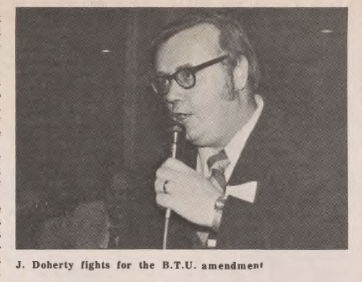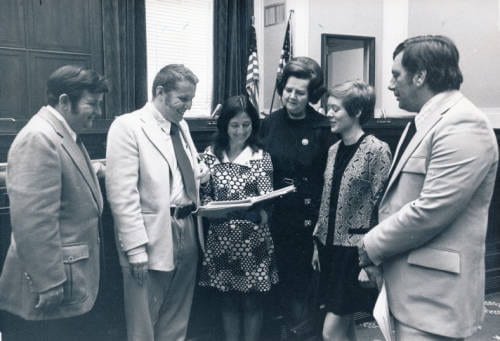January
In the years prior to 1974, residents of Boston were well aware that segregation was a persistent problem in their schools. “Like many other cities,” wrote BTU member Paul Salterio in the January edition of the Boston Union Teacher, “Boston’s long standing problems have at last come to the surface. Among the city’s problems, the issue of quality integrated education is in the forefront.” Teachers were already preparing themselves for momentous changes in the schools, though they could not have predicted the violence that would follow.

John Doherty, BTU President, discusses the “BTU Amendment” to the preliminary plans for desegregation in Boston’s Public Schools. This amendment, as of January 1974, was relatively vague. It aimed to “coordinate with city agencies and community groups in order to minimize the difficulties which are created by the plan.” (Photo courtesy UMB Archives. Detail.)
March
“The string has run out.”
Federal Judge to the Boston School Committee
By March, the Boston School Committee knew that their ability to appeal and further stall desegregation efforts was over. For the past nine years the committee had ignored all protests against inequality, even in the face of a Racial Imbalance Act passed by the Massachusetts Legislature in 1965 mandating that public schools maintain a proper balance in regard to racial makeup of students.
The Boston Teachers’ Union, meanwhile, clarified that even though “recent favorable publicity has blurred the position” of the Union on the issue of desegregation, they still officially opposed the measure. Their perspective was that “this was a bad plan in that it was educationally disruptive while failing to do what it had intended to do.” That is, the BTU believed that the city’s desegregation plan would be equal parts disruptive and ineffective.
May
While desegregation was the chief issue within Boston Public Schools and the BTU, there were other problems demanding the attention of teachers, as there always are. The Union was in an ongoing struggle over pay for teachers’ aides, a sub-group that included a not insignificant number of Black professionals represented by the BTU. As teacher Tom Gosnell discusses in the oral history above, Union President John Doherty was attempting to maintain a neutral front in the face of major changes rapidly approaching Boston’s schools.

This image from the March issue of the Boston Union Teacher illustrates the issues the union juggled in 1974. Teachers picketed in support of teacher aides fighting for a salary raise, all while the BTU officially maintained a stance against state-mandated desegregation.
It is important to reflect on the fact that while white teachers in the BTU were able to remain neutral during the rising concern around desegregation, Black teachers and parents were thrust into conversations around their identity and their children’s educational futures. The official stance of the BTU reflected the privilege many of its members held. Their children were generally not the ones in underfunded and underserved schools.
Continue to June – August: Judge Garrity’s Decision
